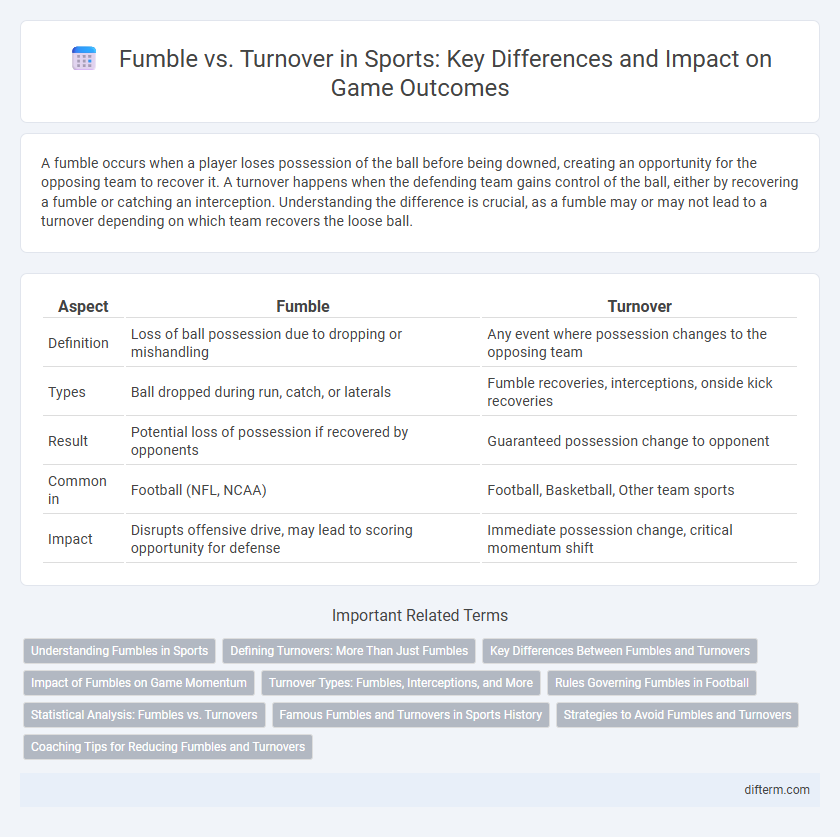A fumble occurs when a player loses possession of the ball before being downed, creating an opportunity for the opposing team to recover it. A turnover happens when the defending team gains control of the ball, either by recovering a fumble or catching an interception. Understanding the difference is crucial, as a fumble may or may not lead to a turnover depending on which team recovers the loose ball.
Table of Comparison
| Aspect | Fumble | Turnover |
|---|---|---|
| Definition | Loss of ball possession due to dropping or mishandling | Any event where possession changes to the opposing team |
| Types | Ball dropped during run, catch, or laterals | Fumble recoveries, interceptions, onside kick recoveries |
| Result | Potential loss of possession if recovered by opponents | Guaranteed possession change to opponent |
| Common in | Football (NFL, NCAA) | Football, Basketball, Other team sports |
| Impact | Disrupts offensive drive, may lead to scoring opportunity for defense | Immediate possession change, critical momentum shift |
Understanding Fumbles in Sports
A fumble in sports, especially in football, occurs when a player loses possession of the ball before being downed or scoring. This sudden loss of control can instantly swing momentum, often resulting in a turnover if the opposing team recovers the ball. Understanding the mechanics of a fumble is crucial for teams to minimize mistakes and capitalize on defensive opportunities.
Defining Turnovers: More Than Just Fumbles
Turnovers in sports encompass any loss of possession to the opposing team, including fumbles, interceptions, and onside kicks. While a fumble specifically refers to the dropping or losing control of the ball during a play, turnovers also involve passes caught by the defense or intentional plays resulting in possession changes. Understanding turnovers is crucial for analyzing game strategy since they significantly impact momentum and scoring opportunities.
Key Differences Between Fumbles and Turnovers
Fumbles occur when an offensive player loses possession of the ball before being downed, whereas turnovers encompass any loss of possession to the opposing team, including interceptions and fumbles. The key difference lies in the type of play causing the possession change: fumbles result specifically from mishandling the ball during a play, while turnovers refer broadly to turnovers on downs, interceptions, and fumbled recoveries. Understanding these distinctions is crucial for analyzing game strategies and player performance metrics in football.
Impact of Fumbles on Game Momentum
Fumbles in football often cause sudden shifts in game momentum by giving the opposing team unexpected possession, disrupting offensive rhythm. Turnovers resulting from fumbles can energize the defense and crowd, increasing pressure on the offense. Statistical analysis shows teams forcing multiple fumble turnovers have a significantly higher chance of winning due to this psychological and tactical advantage.
Turnover Types: Fumbles, Interceptions, and More
Turnovers in football include fumbles, interceptions, and other instances where a team loses possession to the opponent. Fumbles occur when a player loses control of the ball before being downed, while interceptions happen when a defender catches a forward pass intended for an offensive player. Understanding these turnover types is crucial for analyzing game momentum and defensive effectiveness.
Rules Governing Fumbles in Football
In football, a fumble occurs when a player loses possession of the ball before being downed, and the rules allow either team to recover and advance the ball. Fumble recovery is crucial in determining possession change, often leading to a turnover if the opposing team secures the ball. The NFL mandates that the ball must be controlled after a fumble for possession to be retained, and officials use instant replay to verify recovery and ruling accuracy.
Statistical Analysis: Fumbles vs. Turnovers
Statistical analysis reveals that fumbles contribute significantly to turnover rates in sports, with approximately 35% of turnovers resulting directly from fumbles. Teams that secure the ball effectively reduce their turnover margin by nearly 20%, highlighting the critical impact of ball security on game outcomes. Data indicates that managing fumble recoveries improves overall possession metrics, correlating strongly with higher win percentages.
Famous Fumbles and Turnovers in Sports History
Famous fumbles and turnovers in sports history have dramatically altered the outcomes of iconic games, such as Leon Lett's infamous fumble during the 1993 Super Bowl XXVII, which nearly cost the Dallas Cowboys the championship. The 1987 Super Bowl XXI featured a critical turnover when the Denver Broncos' quarterback John Elway's fumble was recovered by the New York Giants, shifting momentum decisively. Iconic moments like these continue to highlight the significance of ball security and decisive plays in football lore.
Strategies to Avoid Fumbles and Turnovers
Teams implement ball security drills and emphasize proper hand placement to minimize fumbles during games. Coaches design play strategies that balance risk and control, reducing chances of risky passes or aggressive plays leading to turnovers. Emphasizing mental focus and situational awareness helps players make safer decisions, significantly lowering turnover rates.
Coaching Tips for Reducing Fumbles and Turnovers
Coaches should emphasize ball security drills that simulate game pressure to reduce fumbles and turnovers, reinforcing proper hand placement and grip techniques. Teaching players to make quick, decisive decisions under pressure minimizes hesitation and improves overall ball control. Incorporating film study to analyze turnover situations helps identify and correct recurring mistakes, leading to smarter, safer play.
fumble vs turnover Infographic

 difterm.com
difterm.com